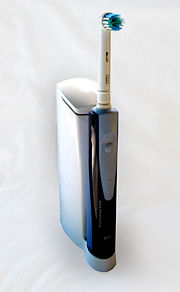Toothbrush
The toothbrush is an instrument consisting of a small brush on a handle used to clean teeth through tooth brushing. Toothpaste, often containing fluoride, is commonly added to a toothbrush to aid in cleaning. Toothbrushes are offered with varying textures of bristles, and come in many different sizes and forms. Most dentists recommend using a toothbrush labelled "Soft", since firmer bristled toothbrushes can damage tooth enamel and irritate gums as indicated by the American Dental Association[1]. Toothbrushes are often made from synthetic fibers, although natural toothbrushes are also known in many parts of the world.
Contents |
History
A variety of oral hygiene measures have been used since before recorded history. This has been verified by various excavations done all over the world, in which chewsticks, tree twigs, bird feathers, animal bones and porcupine quills were recovered.
Many peoples used different forms of toothbrushes. Indian medicine (Ayurveda) has used the neem tree (a.k.a. daatun) and its products to create toothbrushes and similar products for millennia. A person chews one end of the neem twig until it somewhat resembles the bristles of a toothbrush, and then uses it to brush the teeth. In the Muslim world, the miswak, or siwak, made from a twig or root with antiseptic properties has been widely used since the Islamic Golden Age. Rubbing baking soda or chalk against the teeth was also common.
The first toothbrush to resemble the modern toothbrush is believed to have been invented in China in the late 1400s,[2] which used the stiff hairs from a hog's neck, attached to a bamboo stick.

William Addis of England is credited with creating the first mass-produced toothbrush in 1780. In 1770 he had been placed in jail for causing a riot. While in prison, he decided that the method for teeth brushing of the time – rubbing a rag on one's teeth with soot and salt – could be improved. So he took a small animal bone, drilled small holes in it, obtained some bristles from a guard, tied them in tufts, then passed the bristles through the holes on the bone and glued them. He soon became very wealthy. He died in the year 1808 and left the business to his eldest son, William II.
The first patent for a toothbrush was by H. N. Wadsworth in 1857 (US Patent No. 18,653) in the United States, but mass production of the product in America only started in 1885. The rather advanced design had a bone handle with holes bored into it for the Siberian Boar hair bristles. Boar wasn't an ideal material; it retained bacteria, it didn't dry well, and the bristles would often fall out of the brush. It wasn't until World War II, however, that the concept of brushing teeth really caught on in the U.S., in part because it was part of American soldiers' regular daily duty to clean their teeth. It was a practice that they brought back to their home life after the conclusion of the war.

Natural bristles (from animal hair) were replaced by synthetic fibers, usually nylon, by DuPont in 1938. The first nylon bristle toothbrush, made with nylon yarn, went on sale on February 24, 1938. The first electric toothbrush, the Broxodent, was introduced by the Bristol-Myers Company (now Bristol-Myers Squibb) at the centennial of the American Dental Association in 1959.
In January 2003, the toothbrush was selected as the number one invention Americans could not live without, beating out the automobile, computer, cell phone, and microwave oven, according to the Lemelson-MIT Invention Index.[2]
Electric toothbrushes

The first electric toothbrush was developed in 1939 in Scotland, but did not appear on the open market until the 1960s, when it was marketed as the Broxodent in the United States by Squibb. In 1961, General Electric introduced a rechargeable cordless toothbrush that moved up and down when activated.
In 1987, the first rotary action toothbrush for home use, the Interplak, appeared in shops for the general public. There are currently many different varieties of model that use this mechanism.
Use
- squeeze paste on toothbrush
- Use short, back-and-forth brushing motions to clean the outside and inside surfaces of the teeth, as well as the chewing surfaces. Follow with up-and-down motions to clean the inside surfaces of the front teeth.
- Brush along the gum line. This is extremely important, as gum disease starts here. Brush gently to avoid damaging gums.
- Make sure to brush the back molars, where bacteria like to hide.
- Brush the teeth at least 60 seconds (30 seconds is not long enough).
- Brush the tongue to remove bacteria that cause bad breath.
- Spit out the toothpaste and rinse with water or mouthwash.
- Dentists recommend flossing before or after brushing. Adults should try to floss at least once a day, since most adult cavities occur between teeth. The most important time to floss is before going to bed. Guide the floss between the teeth and use it to gently rub the side of each tooth.
See also
- Oral hygiene
- Dental floss
- Toothpaste
- Chewable toothbrush
- Electric toothbrush
- Ultrasonic cleaning
- Miswak
References
- ↑ [1] "Oral Longevity," American Dental Association brochure (PDF), page 2] Retrieved June 12, 2008
- ↑ "Who Invented the Toothbrush and When Was It Invented?".
External links
- American Dental Association statements on Toothbrushing
- International Toothbrush Collection, a searchable database
- BBC h2g2 The History of Toothpaste and Toothbrushes
|
||||||||||||||||||||||||||